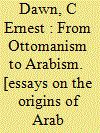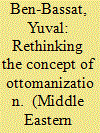|
|
|
Sort Order |
|
|
|
Items / Page
|
|
|
|
|
|
|
| Srl | Item |
| 1 |
ID:
039979


|
|
|
|
|
| Publication |
London, University of Illinois Press, 1973.
|
| Description |
ix, 212p.hbk
|
| Standard Number |
0252002024
|
|
|
|
|
|
|
|
|
|
|
|
Copies: C:1/I:0,R:0,Q:0
Circulation
| Accession# | Call# | Current Location | Status | Policy | Location |
| 012818 | 956.015/DAW 012818 | Main | On Shelf | General | |
|
|
|
|
| 2 |
ID:
089121


|
|
|
|
|
| Publication |
2009.
|
| Summary/Abstract |
An examination of the diverse Hebrew newspapers published in Palestine in the aftermath of the Young Turk Revolution of 1908 teaches us a great deal about the complexity of the term Ottomanism, which was interpreted differently by the Empire and the minorities remaining within its shrinking borders. Whereas the Empire officially perceived Ottomanism as a new form of hybrid identity which would substitute existing national identities, the yishuv's various sectors envisioned a decentralized empire under the house of Osman. In this sense, the Revolution encouraged the emergence of a shared national vision among many circles in the yishuv, although each group still strove to shape the character of the Zionist community in Palestine according to its own agenda.
|
|
|
|
|
|
|
|
|
|
|
|
|
|
|
|
| 3 |
ID:
123428


|
|
|
|
|
| Publication |
2013.
|
| Summary/Abstract |
Turkey is in the process of formulating its new foreign-policy discourse on Sub-Saharan Africa. The emerging discourse is reaching for old themes like Ottomanism and Islamic humanitarianism, and for newer themes such as "the trading-state." The Turkish experience of Sub-Saharan Africa is not rich, and hence the reliance of actors on themes developed in geographical regions quite other than Sub-Saharan Africa. Typically in the early stages of such discourse, its themes reflect images of the major actors more than the realities. As actors' understanding of a subject area improves, the early themes of a discourse are necessarily adjusted to accommodate the issues that emerge in that area. Adjustment happens also in response to various agents' critical commentaries. It is, therefore, a foregone conclusion that the foreign-policy discourse on Sub-Saharan Africa that has emerged so far will undergo constant adjustment.
|
|
|
|
|
|
|
|
|
|
|
|
|
|
|
|
| 4 |
ID:
186145


|
|
|
|
|
| Summary/Abstract |
In the late nineteenth and early twentieth centuries, the style of Ottoman textiles underwent a remarkable shift. This study examines this shift through the case of the Hereke Imperial Factory, a showcase of Ottoman modernism, from the factory’s foundation to the run up to the First World War. In this study, I draw on Ottoman archival records and sources found at the Hereke factory library to show how the style of the textiles produced at the factory was gradually ‘nationalized’ under the reigning political ideology of the day. I also argue that the evolving styles produced by the designers at the Hereke factory were not merely a reflection of the political culture of the era but also, and more significantly, an active factor in shaping that culture. When creating their designs, the designers at Hereke consciously sought to revive the past, and over time, I show, the aspects of the past they embraced for this purpose changed in important ways, gradually shifting from European-style ornamentation to more ‘authentic’ Ottoman styles that were in reality an entirely new synthesis of earlier Eastern designs. That is, designers effectively created a self-consciously ‘Ottoman style’ for the first time, paralleling the efforts of the empire around them to forge a modern imperial identity. I devote particular attention to Tovmas Effendi, an Armenian painter and Hereke’s chief draftsman, to demonstrate how the idea of Ottomanism crystalized in carpet design.
|
|
|
|
|
|
|
|
|
|
|
|
|
|
|
|
|
|
|
|
|